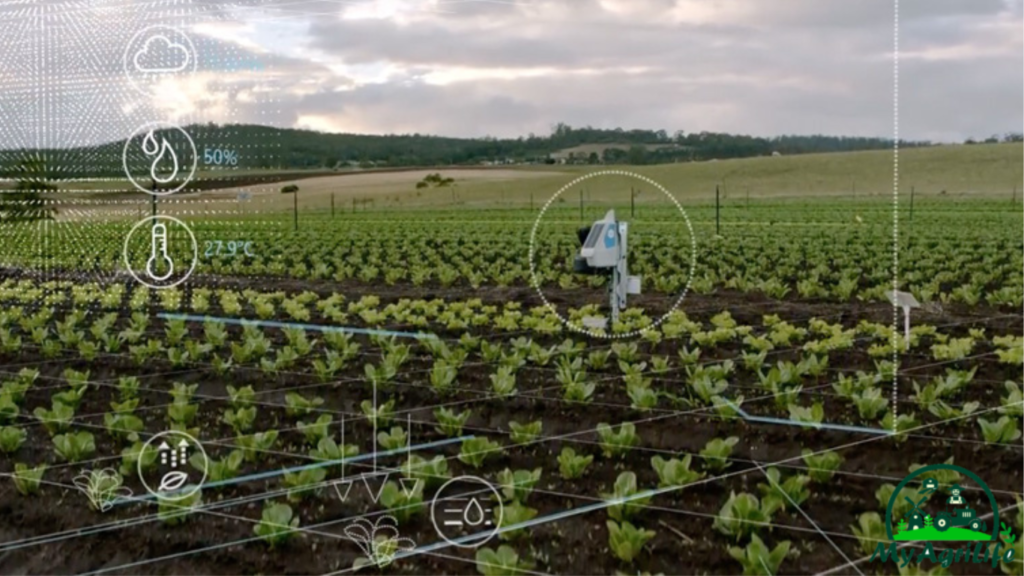
Robotics in farming is the use of robotic systems and automation technology to perform various agricultural tasks, including planting, harvesting, spraying, weeding, and monitoring crops. These systems can be autonomous or remotely operated, and they are designed to increase efficiency, reduce labor costs, and improve yields.
Robotic systems used in farming include autonomous mobile robots, unmanned aerial vehicles, and robotic arms. Autonomous mobile robots can perform tasks such as planting, spraying, and weeding, while unmanned aerial vehicles can survey crops and identify areas of stress. Robotic arms can harvest, prune, and pack fruits and vegetables.
The use of robots in farming has many advantages, including increased efficiency, reduced labor costs, and increased yields. Robots can also provide new opportunities for data-driven decision-making and enhance sustainability by reducing the use of chemicals, conserving water, and minimizing soil erosion.
Despite some challenges associated with the use of robots in farming, such as cost and integration, the technology is rapidly evolving and becoming more accessible to farmers of all sizes. The future of robotics in farming looks very promising, with advancements in technology and increasing adoption expected to further transform the agriculture industry.
Here is a table outlining some key points about robotics for farming tasks:
| Topic | Key Points |
| Definition | Robotics refers to the use of machines that can perform tasks autonomously or with minimal human intervention. |
| Advantages of using robots for farming | Robots can improve efficiency and productivity, reduce labor costs, and enable more precise and consistent farming practices. They can also help to address labor shortages in agriculture. |
| Types of farming tasks that can be automated | Tasks that can be automated include planting, harvesting, weeding, fertilizing, and spraying. |
| Types of robots used in farming | The most common types of robots used in farming are autonomous mobile robots, unmanned aerial vehicles (UAVs), and robotic arms. |
| Autonomous mobile robots | Autonomous mobile robots can be used for tasks such as planting and spraying. They can navigate around obstacles and avoid collisions using sensors and mapping technology. |
| Unmanned aerial vehicles (UAVs) | UAVs can be used for tasks such as crop monitoring and spraying. They can cover large areas quickly and provide high-resolution images of crops. |
| Robotic arms | Robotic arms can be used for tasks such as harvesting and pruning. They can be programmed to perform precise and consistent movements. |
| Challenges of using robots in farming | Challenges include the high cost of robotics technology, the need for specialized skills to operate and maintain robots, and the limited ability of robots to adapt to changing conditions in the field. |
| Future of robotics in farming | The use of robotics in farming is expected to continue to grow, driven by advances in technology and the need to address labor shortages and improve efficiency in agriculture. However, widespread adoption may take time due to the high cost and other challenges associated with robotics. |
Definition
Robotics farming refers to the application of robotics technology in agriculture to perform various tasks such as planting, harvesting, weeding, spraying, and monitoring crops. Robotics in farming involves the use of machines that can operate autonomously or with minimal human intervention to increase efficiency, productivity, and precision. These machines can be equipped with sensors, cameras, and mapping technology to navigate around obstacles, avoid collisions, and collect data about crop health and growth. The aim of robotics farming is to improve the sustainability and profitability of agriculture while reducing labor costs and addressing labor shortages in the industry.
Advantages of using robots for farming
There are several advantages of using robots for farming, including:
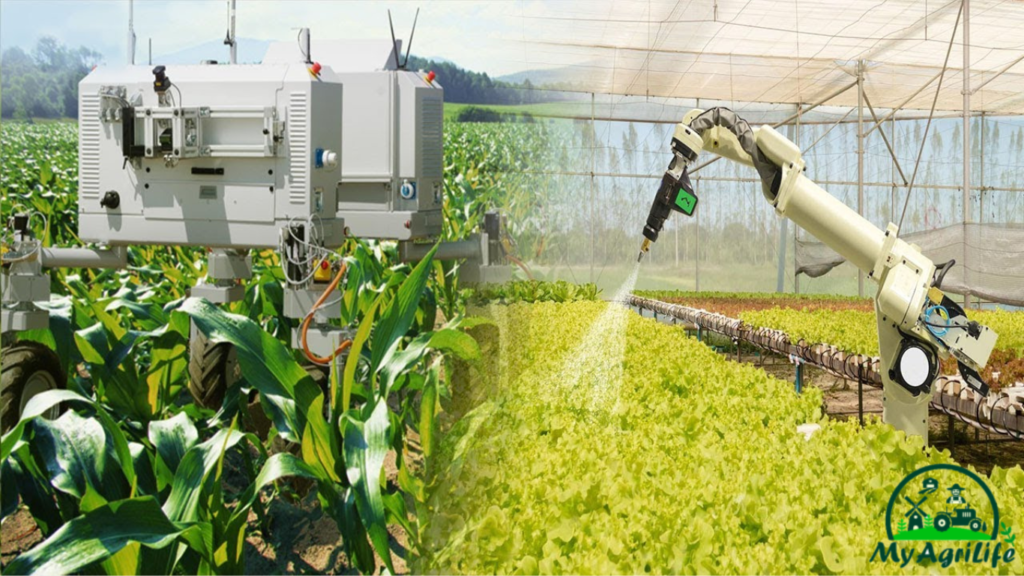
1.Increased efficiency and productivity: Robots can work continuously without getting tired or taking breaks, which can lead to higher efficiency and productivity. They can also perform tasks more quickly and accurately than humans, resulting in faster and more consistent results.
2.Cost savings: The use of robots can reduce labor costs and the need for manual labor in agriculture, which can lead to significant cost savings for farmers.
3.Precision farming: Robots can be programmed to perform precise movements and actions, enabling farmers to apply inputs like water, fertilizers, and pesticides more accurately and in a targeted way. This can help to reduce waste and improve crop yields.
4.Improved safety: Robots can perform dangerous tasks, such as handling chemicals or operating heavy machinery, without putting human workers at risk. This can help to improve safety on farms and reduce the risk of accidents.
5.Addressing labor shortages: The agriculture industry has been facing labor shortages in recent years, and the use of robots can help to fill the gap. With robots taking on some of the more labor-intensive tasks, human workers can focus on higher-skilled activities that require more critical thinking and decision-making.
Overall, the use of robots in farming can lead to increased efficiency, productivity, and profitability, while reducing labor costs and improving safety.
Types of farming tasks that can be automated
Several farming tasks can be automated using robotics technology, including:
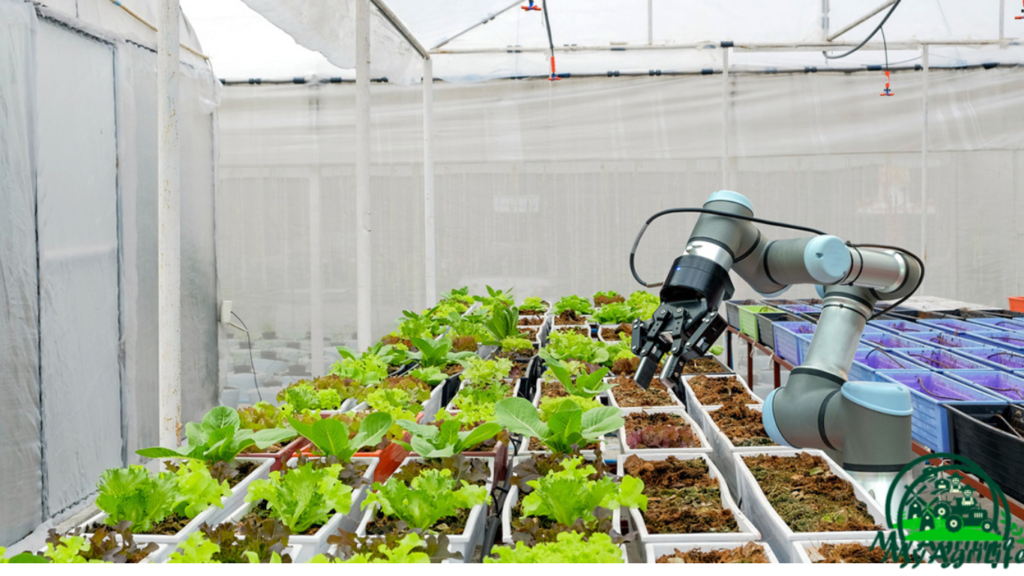
1.Planting: Robots can plant seeds with precision and consistency, reducing the need for manual labor and improving crop yields.
2.Weeding: Robots can identify and remove weeds using sensors and computer vision, reducing the need for herbicides and improving crop yields.
3.Fertilizing: Robots can apply fertilizers and other nutrients more accurately and in a targeted way, reducing waste and improving crop yields.

4.Spraying: Robots can apply pesticides and other chemicals more accurately and in a targeted way, reducing waste and improving crop yields.
5.Crop monitoring: Robots can collect data about crop health and growth, enabling farmers to make more informed decisions about irrigation, fertilization, and other inputs.
6.Pruning: Robots can perform precise and consistent pruning of trees and vines, improving crop yields and reducing labor costs.
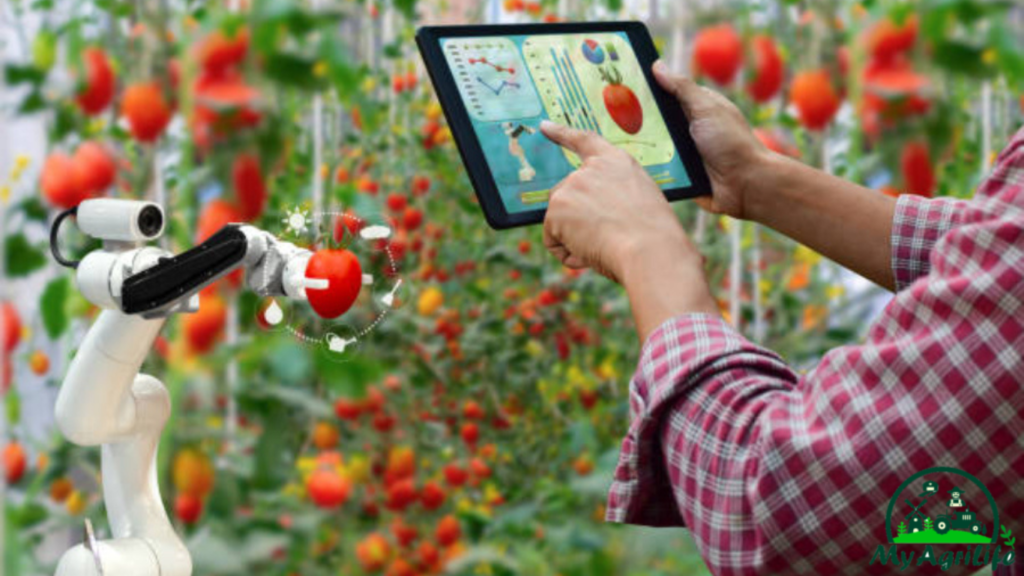
7.Harvesting: Harvesting can be a time-consuming and labor-intensive task, but robots can perform this task more quickly and efficiently than humans.
Overall, automation of farming tasks using robotics technology can lead to increased efficiency, precision, and consistency, while reducing the need for manual labor and improving crop yields.
Types of robots used in farming
Several types of robots are used in farming, including:
1.Autonomous mobile robots: These robots are equipped with sensors and mapping technology that enables them to navigate around obstacles and avoid collisions while performing tasks like planting, spraying, and monitoring crops.
2.Unmanned aerial vehicles (UAVs): Also known as drones, UAVs are used for tasks such as crop monitoring, mapping, and spraying. They can cover large areas quickly and provide high-resolution images of crops.
3.Robotic arms: These robots can be programmed to perform precise and consistent movements for tasks like harvesting, pruning, and packing. They can be mounted on vehicles or stationary structures and are often used in greenhouse operations.
4.Autonomous tractors: These self-driving tractors can be used for tasks such as tilling, planting, and harvesting, reducing the need for manual labor and improving efficiency.
5.Data-collecting robots: These robots are used for tasks such as monitoring soil moisture, tracking weather patterns, and collecting data about crop health and growth. They can be equipped with sensors and cameras to collect data in real-time.
6.Milking robots: These are robots that automate the process of milking cows, reducing the need for human labor.
7.Sorting and grading robots: These are machines that use computer vision and other technologies to sort and grade fruits and vegetables based on size, color, and other parameters.
8.Seeding robots: These are machines that can accurately and efficiently plant seeds, improving crop yields and reducing labor costs.
Overall, the types of robots used in farming are varied and depend on the specific tasks being performed. They can range from small, lightweight drones to large, heavy-duty tractors, and are often customized to meet the specific needs of the farm operation.
Autonomous mobile robots (AMRs) are a type of robot used in farming that can operate autonomously, without the need for human intervention. These robots are equipped with sensors, cameras, and other technology that enables them to navigate around obstacles, avoid collisions, and perform tasks like planting, spraying, and monitoring crops.
Autonomous mobile robots
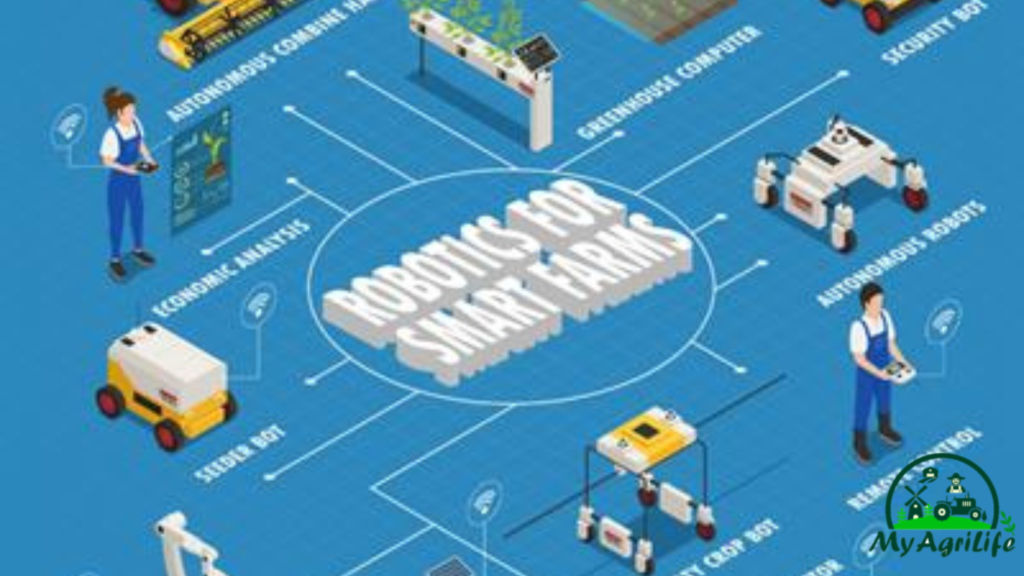
AMRs are designed to be flexible and adaptable, allowing them to perform a variety of tasks on the farm. They can be programmed to perform specific tasks or operate in a more general capacity, depending on the needs of the farm operation. Some examples of tasks that AMRs can perform include:
1.Planting: AMRs can be programmed to plant seeds with precision and consistency, improving crop yields and reducing the need for manual labor.
2.Spraying: AMRs can apply pesticides and other chemicals more accurately and in a targeted way, reducing waste and improving crop yields.
3.Crop monitoring: AMRs can collect data about crop health and growth, enabling farmers to make more informed decisions about irrigation, fertilization, and other inputs.
4.Harvesting: AMRs can perform the task of harvesting crops, reducing the need for manual labor and improving efficiency.
One of the key benefits of using AMRs in farming is that they can operate 24/7, without getting tired or taking breaks, leading to increased efficiency and productivity. They can also work in adverse weather conditions and challenging terrain, making them ideal for use on farms.
Unmanned aerial vehicles (UAVs)
Unmanned aerial vehicles (UAVs), also known as drones, are a type of robot used in farming that can fly over farmland and collect data or perform tasks from the air. UAVs are equipped with cameras, sensors, and other technology that enables them to capture high-resolution images and collect data about crops and the environment.
Some of the tasks that UAVs can perform in farming include:
1.Crop monitoring: UAVs can collect data about crop health and growth, including identifying areas of stress, disease, or infestation, and help farmers make informed decisions about irrigation, fertilization, and other inputs.
2.Mapping: UAVs can produce detailed maps of fields and farms, which can be used for precision agriculture and other farm management purposes.
3.Spraying: UAVs can be equipped with tanks and nozzles to spray pesticides, fertilizers, and other chemicals, reducing the need for manual labor and improving accuracy.
4.Crop scouting: UAVs can quickly and efficiently survey crops, identifying issues like plant stand, moisture, nutrient deficiencies, and plant stress.
5.Livestock monitoring: UAVs can be used to monitor livestock, such as counting animals, identifying potential health issues, and monitoring grazing patterns.
The use of UAVs in farming can provide farmers with real-time, high-resolution data about their crops and land, enabling them to make more informed decisions and improving productivity and efficiency. UAVs can cover large areas quickly and easily, providing a more cost-effective and efficient solution than traditional methods.
Robotic arms
Robotic arms are a type of robot used in farming that are designed to perform specific tasks with precision and consistency. These robots are typically mounted on vehicles or stationary structures and are used for tasks like harvesting, pruning, and packing. Robotic arms are programmed to perform precise and repeatable movements, improving efficiency and reducing the need for manual labor.
Some of the tasks that robotic arms can perform in farming include:
1.Harvesting: Robotic arms can pick fruits and vegetables with precision and consistency, reducing the need for manual labor and improving efficiency.
2.Pruning: Robotic arms can be programmed to prune plants with precision, reducing the risk of damage and improving plant health.
3.Packing: Robotic arms can sort and pack fruits and vegetables with precision and speed, reducing the need for manual labor and improving efficiency.
4.Seeding: Robotic arms can plant seeds with precision and consistency, reducing the risk of uneven planting and improving crop yields.
Robotic arms can be customized to meet the specific needs of a farm operation, with different attachments and sensors available for different tasks. They can be used in conjunction with other types of robots, such as autonomous mobile robots and unmanned aerial vehicles, to provide a comprehensive and efficient solution for farm tasks. The use of robotic arms in farming can reduce labor costs, improve efficiency, and increase crop yields.
Challenges of using robots in farming
While the use of robots in farming has many advantages, there are also some challenges that need to be addressed. Here are some of the main challenges of using robots in farming:
1.Cost: Robots can be expensive to purchase and maintain, which can make it difficult for smaller farms with limited budgets to adopt the technology.
2.Integration: Integrating robotic systems into existing farming operations can be challenging, as it may require significant changes to equipment, infrastructure, and workflows.
3.Maintenance and repair: Robots require regular maintenance and repair, which can be difficult and expensive, particularly for farms located in remote areas.
4.Limited functionality: While robots can perform many tasks, there are still some tasks that they are not capable of performing, such as tasks that require a human touch or manual dexterity.
5.Environmental challenges: Robots can be affected by environmental factors such as weather, soil conditions, and terrain, which can impact their effectiveness and efficiency.
6.Technical expertise: The use of robots in farming requires technical expertise, which may be lacking in some farming communities.
7.Legal and regulatory challenges: The use of robots in farming is subject to various legal and regulatory requirements, which may vary depending on the jurisdiction.
Despite these challenges, the use of robots in farming is growing, and many farms are adopting the technology to improve efficiency, reduce labor costs, and increase yields.
Future of robotics in farming
The future of robotics in farming looks very promising, as the technology continues to advance and become more accessible to farmers of all sizes. Here are some of the key trends and developments that are shaping the future of robotics in farming:
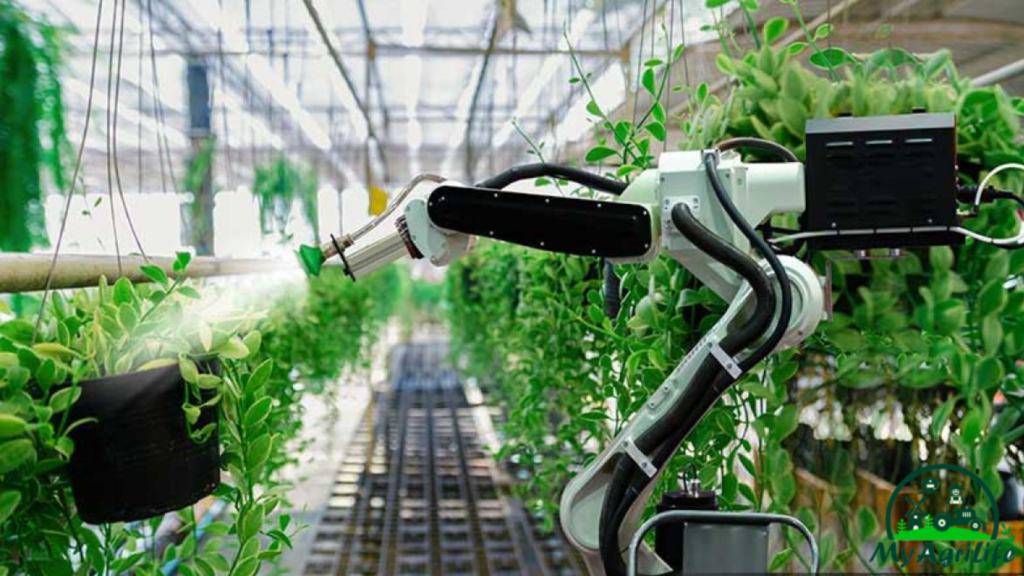
1.Increasing adoption: The adoption of robotic systems in farming is expected to continue to increase, as farmers seek to improve efficiency, reduce labor costs, and increase yields.
2.Advancements in technology: The development of new technologies, such as machine learning, artificial intelligence, and computer vision, is expected to enhance the capabilities of robotic systems in farming.
3.Customization: Robotic systems are becoming increasingly customizable, with a range of attachments and sensors available for different tasks and applications.
4.Collaboration: The integration of different types of robotic systems, such as autonomous mobile robots, unmanned aerial vehicles, and robotic arms, is expected to provide a more comprehensive and efficient solution for farming tasks.
5.Sustainability: The use of robotic systems in farming has the potential to improve sustainability by reducing the need for chemicals, conserving water, and minimizing soil erosion.
6.Accessibility: The cost of robotic systems is expected to continue to decrease, making the technology more accessible to smaller farms with limited budgets.
7.Data-driven decision-making: The use of robotic systems in farming generates large amounts of data, which can be used to make more informed decisions about crop management, inputs, and other factors.
Overall, the future of robotics in farming looks very promising, as the technology continues to evolve and become more accessible. The use of robotic systems in farming is expected to improve efficiency, reduce labor costs, and increase yields, while also enhancing sustainability and providing new opportunities for data-driven decision-making.
conclusion
In conclusion, robotics is revolutionizing the agriculture industry by providing a range of solutions to the challenges faced by farmers. From autonomous mobile robots that can perform a range of tasks to unmanned aerial vehicles that can survey crops and identify areas of stress, to robotic arms that can harvest, prune, and pack fruits and vegetables, robots are transforming the way farming is done.
The use of robots in farming has numerous advantages, including increased efficiency, reduced labor costs, and increased yields. Robots are also providing new opportunities for data-driven decision-making and enhancing sustainability by reducing the use of chemicals, conserving water, and minimizing soil erosion.
While there are some challenges associated with the use of robots in farming, such as cost, integration, and maintenance, the technology is evolving rapidly, and many of these challenges are being addressed.
Overall, the future of robotics in farming looks very promising, as the technology continues to advance and become more accessible to farmers of all sizes. Robotics is set to play an increasingly important role in the agriculture industry, providing new solutions to the challenges faced by farmers and helping to ensure a more sustainable and efficient food supply for the future.









